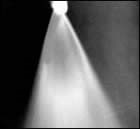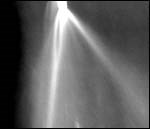Nozzle Maintenance for Finishing Fitness
A look at common problems with spray nozzles, and how to minimize them.
Finishing applications can employ up to hundreds of spray nozzles that, like any other equipment, need routine maintenance in order to properly do their job. Anyone who powder-coats or e-coats is rinsing and finishing, and in the case of powder coating, there is a pretreatment stage. A consistent spray pattern and complete and uniform spray coverage is very important to the quality of your finished product.
The type of nozzle you choose can be a primary factor affecting both maintenance requirements and overall finishing performance. Threaded steel, stainless, or brass nozzles are not only subject to corrosion, they are often aimed in a single permanent direction. This obviously decreases their application flexibility.
Modern polypropylene nozzles, on the other hand, can include such enhancements as quick disconnects and the ability to be easily realigned to produce different spray patterns for different products at different times. In most cases, there are notable cost savings as well.
Frequent inspection of nozzle orifices for clogging is probably the biggest maintenance factor that affects the consistency of spray patterns in any industrial application. Nozzle wear is another important issue that needs to be consistently monitored. Polypropylene and other plastic nozzles (PVDF, PVC, and other materials) that carry abrasive materials will wear, but their service life can be extended with the proper care.
Regular Inspection
Visual inspection can point to malfunctioning nozzles. An example would be uneven or missing spray patterns where the consistency of the spray (flat fan, full cone or hollow cone) can visibly be seen. In flat-fan nozzles, poor performance will most likely be from a change in spray angle. In hollow-cone nozzles, it is common to see a missing pattern in the center or no pattern at all. In full-cone nozzles, the nozzle often becomes completely plugged.
Problems with nozzle spray patterns can result from several sources. The most common causes of poor spray patterns are worn nozzles, damaged nozzle orifices, excessive leaking, and poor nozzle alignment.
Worn Nozzles
If it’s obvious to the eye that the spray pattern has become uneven or incomplete, then there’s a good chance that the nozzle orifice is worn. A worn nozzle may also be the cause of an unwanted increase in the flow rate, which could be accompanied by a drop in system pressure and poor spray pattern performance further from the pump. In extreme situations, you could even see your electrical costs rising.
The fix for a worn nozzle is replacement. To prevent excessive nozzle wear from becoming a problem in your application, maintain regular checks on fluid temperature. It may be too hot for plastic spray nozzles. Maximum temperature for polypropylene nozzles is 175°; PVDF nozzles can handle temperatures to 300°.
Other possible ways to reduce nozzle wear include reducing spraying pressure to reduce the liquid velocity and minimizing the abrasive particle content in the spray stream. If these remedies fail to bring nozzle wear to acceptable levels, consider a different type of nozzle material.
Damaged Orifice
An abused and damaged orifice can also result in an irregular spray pattern that can affect product quality and/or waste materials. Orifice damage often results from improper cleaning of the nozzle. The only fix is replacement of the nozzle.
Users should never use a metallic object to clean nozzles. Fiber brushes, or even a toothbrush or toothpick, are more suitable for plastic nozzles. Nozzles should always be removed for cleaning.
Excessive Leaking
Some dripping or leaking is normal, and is acceptable in some applications. If dripping seems excessive, check for incorrect connections between the nozzle and the pipe fitting or manifold. This could result from, for example, use of an incorrect size during nozzle replacement.
If you’re using clip-on style plastic nozzles, make sure all components are snapped into place securely. Worn O-rings occasionally cause leaking. Drilling an incorrect size hole will cause substantial leakage as well.
Nozzle Misalignment
Many quality and efficiency problems are due to nozzles being aimed incorrectly after they have been removed for cleaning or other maintenance. Few people take the time inside a coating compartment or parts washer to assure that the nozzle is aligned exactly the way it should be, especially if it is in a hard-to-reach area.
Newer quick-disconnect spray nozzles can eliminate misalignment. Positive re-alignment of the tip is automatic, because such tips are simply twisted into the body until the tip locks into place.
Related Content
TTX’s Automated Conveyor Carrier System Offers Wireless, Flexible Operation
ACC system designed for reliable, consistent point-to-point movement of everything from small to heavy parts.
Read MoreProducts Finishing Reveals 2024 Qualifying Top Shops
PF reveals the qualifying shops in its annual Top Shops Benchmarking Survey — a program designed to offer shops insights into their overall performance in the industry.
Read MoreSurface Prep Solution for Rusted Rebar in Concrete
Julie Holmquist of Cortec Corporation discusses passivating corrosion on rebar and other reinforcing metals.
Read MoreCuring Oven Basics
Simply heating up the substrate does not cure the coating. There are many variables to consider when choosing the best cure oven for your application...
Read MoreRead Next
Episode 45: An Interview with Chandler Mancuso, MacDermid Envio Solutions
Chandler Mancuso, technical director with MacDermid Envio discusses updating your wastewater treatment system and implementing materials recycling solutions to increase efficiencies, control costs and reduce environmental impact.
Read MoreEducation Bringing Cleaning to Machining
Debuting new speakers and cleaning technology content during this half-day workshop co-located with IMTS 2024.
Read MoreA ‘Clean’ Agenda Offers Unique Presentations in Chicago
The 2024 Parts Cleaning Conference, co-located with the International Manufacturing Technology Show, includes presentations by several speakers who are new to the conference and topics that have not been covered in past editions of this event.
Read More













.jpg;maxWidth=300;quality=90)










